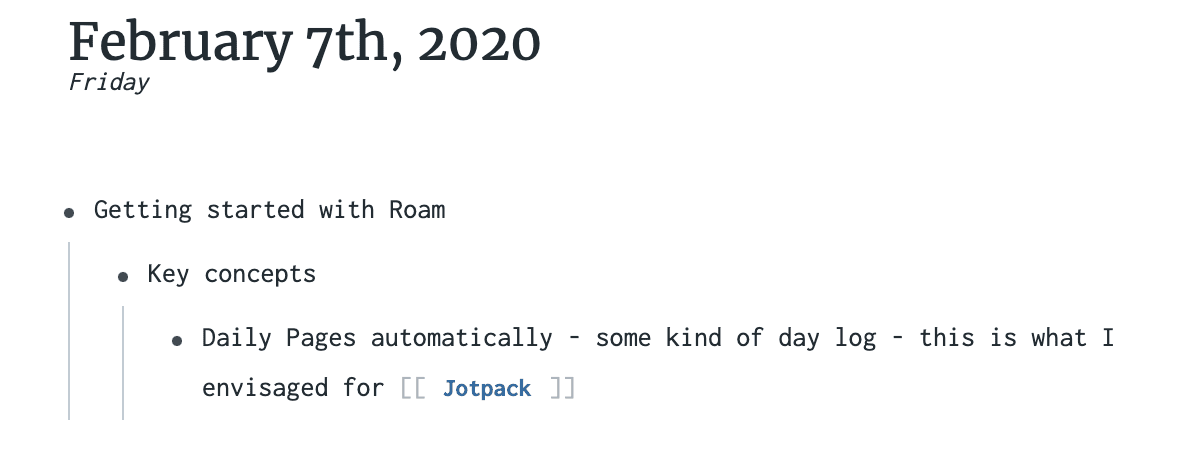I’m publishing this on the 7th February 2021, which marks my 1 year anniversary of using Roam Research. My genesis block shows the first piece of information I added to Roam:

It can often sound like hyperbole, but Roam has changed my life in significant ways in this past year.
So what has a year of living in Roam done for me? I spend many hours of almost every day in Roam. It gives me a place to think, to plan, to write and reflect.
Journaling Consistency
Journaling in Roam has been a game-changer. My thoughts are no longer trapped in paper books that I rarely look at. I can program my attention and set my intentions directly when I plan for the future and reflect on the day.
Asking better questions will get you better answers. Roam has made it easy for me to choose, or choose for me, questions to help me think about my true beliefs and values. Not only that, I can quickly and visually see how my answers change over time.
It led me to Interstitial Journaling, which Roam makes frictionless with the natural daily pages and timestamps. It becomes a natural feedback cycle when you live in Roam with your thoughts front and centre, organised and linked. Easy to add, easy to scan and easy to learn the lessons of the past to improve your future.
Grew my business
I use Roam to plan my projects, flesh out my philosophy and create a vision for my business. I use it to write articles and papers for clients and prospects.
I participated in the Building a Second Brain course, and of course I took notes on it in Roam, but I could also put the ideas presented into practice. Roam’s block-level thinking makes it easier than ever to create Intermediate Packets and reuse and remix previous thoughts and output to create valuable new insights.
The outlining features in Roam make it simple to pick up and rearrange random thoughts over time into something more coherent.
Wrote a course
Sure, being in lockdown helped, but seeing the potential in Roam caused me to want to really learn how to use these new paradigms well to make the most of its benefits. Writing the course in Roam was its own little playground. I’ve always been one to learn through practice and solving practical problems. If I can’t see the practical applications, I struggle.
Through it, I’ve also ended up doing private Roam coaching calls to help others set up Roam to help them get more out of it.
Created a media empire
Ok, it’s a very tiny empire. Following on from the Roam course, I began a newsletter, Letters from a Roaman, to help everyone keep up with the firehose of information and changes that are happening in the Roam eco-system. Beyond curation and community-building, it also serves to help with my own thinking on the relevant topics which I share as a form of “working in public”. Roam makes it easy to produce on a consistent basis in my little free time. It’s another example of the flexibility of Roam in action. I can quickly capture information and add my own thoughts to it. When it’s time to write the newsletter, I’ve already done most of the hard work and it becomes an almost drag and drop operation.
One slight side effect though, is that I have published fewer articles in the last year. I do, however, have many more half-written drafts and ideas. I used to struggle with what I should write about. Now, I have too much! I need to find some time to complete the drafts and hit publish.
Built a Zettelkasten
One of the reasons that I now have no shortage of ideas is my zettelkasten system. Through more thinking and collaboration, and initiatives like the Roam Book Club reading book/How to take smart notes I now more fully understand the nuances of the zettelkasten method. Combined with the 5 fundamentals of Roam and Beau Haan’s innovation to bring a fully realised zettelkasten into the digital age, I finally have a system that works for me. In the past, I tried the ideas of zettelkasten and evergreen notes in various note-taking systems, even Roam, but I rarely got to a point of having what would be considered a permanent or evergreen note. My time-blocks and life were not pursuant to it. Instead, by treating fleeting, literature and permanent notes as 3 phases of matter and the idea that you can go more quickly to shorter permanent notes because notes are threaded and connected through both time and with other notes is a complete game-changer. It prevents paralysis and procrastination because the permanent note isn’t “perfect”. (If you’d like to learn more about this, I’ll be publishing more in future or you can stay in the loop at Chestnut).
Found a Community
Which brings me onto the most surprising and yet most important aspect of Roam, and that is the people. Through my course and newsletter, I have had the opportunity for lots of interactions through email again. It’s been quite a joy to go “old-school” again which is not solely for business. And I’m sure it’s helped me, dare I say, enjoy the COVID lockdowns this past year.
I stopped using Twitter a few years ago, it was too much noise and not enough signal, and it honestly was not conducive to doing good work. When I discovered Roam, I reluctantly fired up Twitter to learn more because I’d heard of this RoamCult thing. I had no clue what it was. I unfollowed most of my old crowd, and instead started following RoamCult members and those who enjoy lifelong learning. It is like night-and-day. I enjoy Twitter again (that’s a dangerous thing too!). My timeline is filled only with a joyful mix of an international, diverse, interesting, and smart people having respectful discussions and fun. It is a community of people who are genuinely nice, and beyond helpful.
It’s through this medium, and initiatives like Fabricating Serendipity (a big hat-tip to Kahlil) that have propelled me forward in ways that I wouldn’t have imagined. I’m excited to be collaborating with Beau, to help bring the joys of Zettelkasten to more people. I am grateful and honoured to have met you all.
And Roam is just getting started, while we have shared graphs where I get to hang out with these people on various projects, we can’t yet fully connect parts of our graphs to another seamlessly. When this becomes possible, having the connected intelligence of these fine folk that transcend places like Twitter, I’m certain, will unlock a trove of discovery.
You should take a year in Roam too, and discover the fresh air for yourself. It’s not just a productive place for work; it may revitalize you from the inside, and you may meet also end up making some new friends for life. I think I might move here permanently. If you need any help getting started, find me on Twitter or you could try my email course.
roam, retrospective
